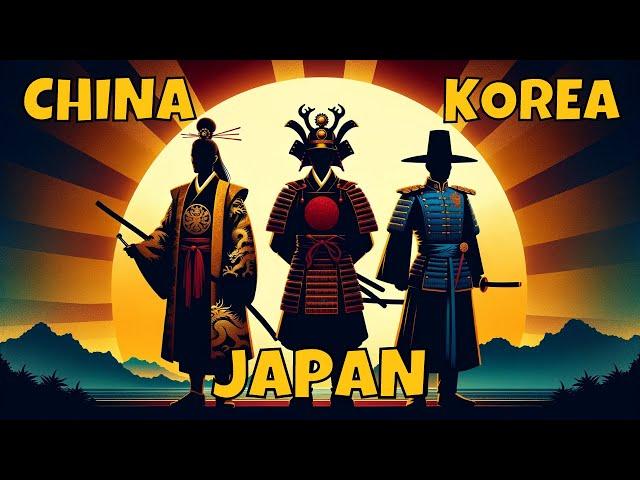
Qing China, Tokugawa Japan, and Joseon Korea - A Complete Overview
We start off where our last megadocumentary left off, with the Ming is nearing its end. While meeting with the Jesuits brought cultural exchange, the Ming soon faced economic, social, and military problems as the Jurchen coalesced into a mighty power in Manchuria, and elevated themselves as a new dynasty, the Qing. After peasant rebellions brought the end of the Ming, the Qing entered and brought stability.
We next go over the influential early Qing rulers, Kangxi, Yongzheng, and Qianlong, and the annexation of Taiwan from Ming loyalists. We then go through the 4 Dzungar-Qing Wars, which resulted in the Qing Empire seizing Mongolia, Tibet, and Xinjiang, to become one of the largest empires in history. After the White Lotus Rebellion, we then deal with culture and literature during the Late Ming and Early Qing and the empires early relations with Western powers, setting up the period of conflict which will come next series.
We then travel to Japan, which remained in the Sengoku Period. The go through the journey of Oda Nobunaga, and Toyotomi Hideyoshi, who ended the Sengoku and united Japan, and Tokugawa Ieyasu, who eventually set up the Tokogawa Shogunate, marking the beginning of the Edo Period, the most prosperous and long lasting in Feudal Japan. We take a look at literature and art styles as well in the new urbanized Japanese cities, all centered around Ukiyo, or the 'floating world'. We also touch on their interactions with Europeans, Christianity, and their Sakoku policy.
Joseon Korea is next, as we focus on the Imjin War and the defense of Admiral Yi Sun-Sin and his famous turtle ships, and invasions by the Jurchen and Manchu.
In Vietnam, we pick up where we left off, and go through the rise of the Le Dynasty, the Mac Dynasty, the Trinh and Nguyen Lords, and finally the Tay Son Rebellion which leads us into the 1800s.
This is the 4th episode of our Early Modern series, which goes over the history of the world from roughly 1500 to 1800. The last episode dealt with the so-called Gunpowder Empires, the Ottomans, Safavid Iran, and Mughal India.
0:00 Late Ming and Early Qing (China)
31:16 Azuchi–Momoyama period and Tokugawa Shogunate (Japan)
53:27 Joseon (Korea)
1:02:15 Dai Viet (Vietnam)
The Early Modern Series:
https://www.youtube.com/playlist?list=PLaWQkkziGGfduFHyHe0AQRVLv7txUiv39
Welcome to Early Modern series of the World History Summarized project! The entire project is meant to summarize broad topics in history and balances political history and events, with social/daily life, and culture. If you've watched our History of the World documentary, the project is a perfect next step. The videos are standalone, but presented in a chronological fashion. This series "the Early Modern" takes place after our megadocumentaries "The Ancient World" and "The Medieval World". It will be divided into 5 videos about the Early Modern period (c. 1500 - 1800) all over the world, and will be called Phase 3. Once these 5 videos are completed, we will move onto Phase 4 of the project, but this series will be considered completed, and compiled into ONE MEGA-DOCUMENTARY containing all 5 parts.
-----
Check out the Sections on our Homepage for the series we are working on:
https://www.youtube.com/c/MadeInHistory
-----
Please subscribe to Made In History for more videos! We are always trying to grow!
All images used with CC license.
Music Used:
Adrian von Ziegler - Into Solitude
Adrian von Ziegler - Isan
Adrian von Ziegler - Night of the Soaring Dragon
Adrian von Ziegler - Panda Power
Alexander Nakarada - Dragonsong
Kevin Macleod - Guzheng City
Kevin Macleod - Oppressive Gloom
Kevin Macleod - Ritual
#worldhistory
#modernhistory
#historyfacts
#eastasia
#history
#historical
#documentary #chinesehistory #japanhistory
Тэги:
#made_in_history #made_in_history_early_modern #world_history #world_history_documentary #world_history_summarized #history_of_the_world #early_modern_history_documentary #made_in_history_east_asia #qing_dynasty #qing_empire_history #taiwan_china #feudal_japan_documentary #tokugawa_shogunate #tokugawa_ieyasu #edo_japan #china_history_documentary #joseon_dynasty #korea_history #imjin_war_1592 #dai_viet_history #vietnam_history #asian_history #east_asian_history #ukiyo_eКомментарии:

한국 일본은 같은 동이족. 중국은 잡족. 대륙백제가 열도로 건너간게 일본. 대륙신라가 경주를 중심으로 한반도에 터잡고. 대륙을 잠시 떠났던 주인 민족이 조만간 다시 대륙으로 돌아갈것.
칭 차이나 라는 명칭도 죄다 동이족 명칭임. 칭은 청. 차이나는 신라의 별칭 진한이 변해서 된거고. 당시 대륙에 있었던 고려가 지금의 코리아로 불리는거고. 실크로드의 주인공 신라. 고려청자의 주인공 고려. 대륙을 왕래했던 세계인들에 의해 명칭이 생겨남.

썸내일 실화냐?ㅋㅋㅋㅋㅋ 똑바로 안해??
Ответить
썸네일보니 킹받네. 한국인 의복이 저게 뭐냐. 선비가 쓰는 갓에 출처도 알 수 없는 이상한 무인옷을 입히다니. 상상으로 만들었니? 동아시아 무식자같으니. 에효…
Ответить
Taiwan used to be called Formosa. Some of this history is not accurate
Ответить
What happened to this thumbnail? 🧐
Look at those clothes!

South Korea vs Japan vs China vs Taiwan vs Hong Kong
Ответить
korea♥Japan
Ответить
Koreans seem to have their own unique history🤔
Ответить
there is full of nationalism comments!
Ответить
やっぱり韓国は歴史が少ない。だからこそ、韓国起源説をたくさんしている。キムチだって実際中国だし、日本の刀だって韓国起源だと主張してたし、他にも日本の桜やお菓子、剣道、侍、武士道、これら全て韓国が起源だと主張する人が居ます。おかしいですね
Ответить
They are very different from one another, but they are all the same to Westerners.
It's still the same today.

Chinese culture is fake. Because Chinese culture was destroyed by Manchus and Mongols. They dont even know the fact that Ming people enjoyed Korean dress and the fact that Ming dress is not hanfu.
They are GoryeoYang(고려양) 💀💀

Chinese people: (pointing at the GoryeoYang)
"Look! Its Chinese hanfu. I think Korean hanbok is a copycat of the Chinese hanfu."
The Chinese ancestors: lol Hongzhi emperor banned that dress. thats GoryeoYang. That is not hanfu.

GoryeoYang(고려양) is common sense in Korea. Because every child have learned about this in school. Its on the text book. GoryeoYang(고려양) is considered as first hallyu that was recorded in history. Since the Yuan dynasty to until the Ming dynasty, Chinese people enjoyed Korean style dress. The GoryeoYang(고려양) was worn by the Chinese people untill the Ming dynasty's Hongzhi emperor banned wearing GoryeoYang.
The modern Chinese people are assuming that Korean Hanbok is a copycat of the Ming dynasty's Hanfu. In fact, it was the Chinese people who wore Korean hanbok during the Ming dynasty. Chinese people need to study about GoryeoYang. The dress from Ming dynasty is not hanfu. They are GoryeoYang(고려양).

Ming dress is not hanfu. Its Korean style dress. East Asian people need to study more. They are GoryeoYang. Not hanfu.
Korean hanbok was not influenced by Chinese hanfu at all. It has totally different design lol
Just look how different the Ming's GoryeoYang is compare to the clothes from Han Tang Song dynasties.

Ming dynasty's dress ≠ Hanfu
Ming dynasty's dress = GoryeoYang
China has influenced on Korean hanbok ❌
Korea has influenced on Chinese hanfu ✅
During Ming dyansty, Chinese people enjoyed Korean hanbok. GoryeoYang is not hanfu. And Korean Hanbok is totally different design with the original Chinese hanfu.

ㅋㅋㅋㅋ 중국인들 겁나 웃기네 ㅋㅋ 원나라 시절부터 명나라 시절까지 지 선조들이 입은 고려양을 중국의 한푸라고 하면서 한국의 한복이 중국의 한푸를 베꼈다고 주장하는 현대 중국인들 ㅋㅋㅋㅋㅋ 한복이 한푸를 베낀게 아니라 지들 조상들이 입은 고려양임 ㅋㅋㅋ 근데 자꾸 한복이 한푸를 베꼈다고 하누 ㅋㅋㅋ 겁나 어처구니가 없누ㅠㅠ
Ответить
Chinese hanfu (especially Ming dynasty) is very similar to Korean hanbok. Because it was influenced by Korean hanbok. From the Yuan dynasty to until the Ming dynasty, Chinese people enjoyed Korean style dress. And its called GoryeoYang (고려양).
In fact, Ming dynasty's dress is not hanfu. They are Korean style Chinese dress (GoryeoYang).
Just look at the records that was written by your (Chinese) ancestors. In Korea, every child learn about GoryeoYang. Its on the text book. Ming dress is GoryeoYang. So stop arguing about it lol Ming dress is not even hanfu. They are copycats of Korean hanbok.
Han Tang Song dress are the real hanfu lol

The north of the Great Wall is not Chinese territory. It was ruled by Mongols, Manchurians, and Koreans. Qin Shi Huang built the Great Wall to block the so-called Northern Orangkai. Later, China was conquered by the Mongolia and also Kim(金) Dynasty founded by descendants of korean Kim Ham-bo.
Manjuwonryugo (滿洲源流考), compiled during the Qianlong Emperor of the Qing Dynasty, also reveals that the national name 金(kim) Dynasty is also derived from the family name 金(kim)of King of Silla(ancient korea).
Also china wad ruled by the Manchurians for 300 years(Qing dynasty)
Sugihara, a professor who published "Japan's Bronze Age from Korea," said, "The Bronze Age came to Japan from 100 BC to AD50, the end of Korean Bronze Age society. In Japan, the Iron Age and the Bronze Age were handed down at the same time during the Yayoi period, and the Bronze Age was only used for ancestral rites, so it seems that it went straight to the Iron Age without going through the Bronze Age."
Around 100 BC – Ancient civilization began in Japan when Koreans landed with iron weapons in Japan, where primitive people in the Stone Age lived. Japanese history is the history of the Korean people
"High-tech science has proven historical truths that no one has ever told you. In other words, Koreans moved to Japan and founded the ancient civilization of Japan. Although traces of the Yayoi civilization, which ended Japan's primitive era and opened up an ancient society, appear throughout the Japanese mainland, it is widely accepted as orthodox that it originated in the northern part of Kyushu by the descendants. The study made it clear that the Yayoi people are descendants of people from the southern part of the Korean Peninsula."
The Han Chinese along with Vietnam, were grouped in a different lineage, showing genetic differences from Koreans.
O2b: This type can be said to be the core of Koreans' unique Y chromosome. It accounts for 37.3 percent of Koreans, but is rarely found in China. O2b is mainly distributed in Japan (31.9 percent) and Manchu (3.8 percent) outside of the Korean Peninsula, so O2b can be said to be a unique gene of Koreans and Japanese people
"direct ancestors of korean are members of the ancient Asian and Tungus ethnic group that migrated from Siberia in the Neolithic Age, and linguistically belong to the Altai ethnic group." "In addition to the Yayoi (Yamato people) of the Doraein line who crossed from the Korean Peninsula, there are also the Ainu lineal descendants of the Jomon people of the indigenous people of the Japanese archipelago."
Japanese civic group claims, "It is the same as the annexation of Korea and Japan, reunification of East and West Germany." 2018-11-2008:30 A report was sent to the U.N. Committee on the Elimination of Racial Discrimination in Korea to demand "correct the fabrication of facts in Korea."
At the time of the annexation of Korea and Japan, the Japanese ruling class thought that they were unified.they granted equal rights to Koreans through "Korea and Japan are One' policy(內鮮一體). In addition, a huge amount of 30 percent of Japan's total budget was poured every year for the modernization of Joseon.
The lives of Koreans have become so abundant that the population, which had remained at the level of 10 million without population growth for 600 years during the Joseon Dynasty, doubled during the Japanese colonial era.
"During the colonial period, Joseon's population grew by 12.6 million people, about 69 percent of whom, 8.7 million, were within the Korean Peninsula and 31 percent were flown to Manchuria and Japan."

キリスト教は奴隷にする日本人を人身売買する邪教だから禁止にした。
Ответить
These are great and super informative, but please do some practice on pronouncing Japanese names, it wasn’t even common mispronouncing it was wholly replacing vowels with completely different ones.
Ответить
영상 지기노
Ответить
대한민국 만세~
Ответить
The Manchurians are now under Chinese control.
Ответить
The narrator here, just like the one over at Kings and Generals, just murder pronunciations in Mandarin, Japanese, and most likely, Korean.
Ответить
The Japan explained here is a mess both before and after the era. The time series is backwards and forwards. Even during the samurai civil war, it was a given for every military commander that Japan would remain one nation under the emperor. The war between samurai is similar to the power struggle today.
Then, the reason why Japan closed off its country and restricted visitors from Europe to Nagasaki was because the Jesuits brainwashed them into trusting them, and they deceived or abducted Japanese men, women, and children to Southeast Asia and Europe. They were brought back and trafficked in Europe. This is also on record. For some reason, there were many Japanese slaves in Portugal and Spain at the time. Some people cut holes in the backs of weak Japanese people's hands and hung them on the deck, leaving them to dry in the sun.

According to the most famous Chinese history book, the Records of the Three Kingdoms written in 280 AD by Chen Shou. there's a separate chapter called Dongyi which describes the Manchurians, Koreans and Japaneses. meaning that from the chinese point of view these people were heterogeneous aliens to the Chinese.
What's even more interesting is that Haplogroup and mDNA researches support this hypothesis, according to those researches, these people are the most closest ethnic groups in Asia but a distinctly different group from the Chinese.
At present, China's vast territorial borders were all extended by the Manchu people of the Qing Dynasty, but why didn't the Qing Dynasty, which was strong enough to conquer many other territories, conquer Joseon like other countries? because they were blood brothers in history like Buyeo, Goguryeo, Balhae.
This is also supported by the 'Researches on Manchu Origins' an official history book that recorded the origins of the Manchurians compiled under the edict of the Qing Dynasty's Qianlong Emperor. that they shared the same origins as the Korean people.

Where vietnam?
Ответить
李舜臣は局地戦でわずかな勝利を得たものの、戦局全体に影響を与えはしなかった。秀吉軍と朝鮮軍に圧倒的な差が有り、秀吉軍はほぼ無敵状態であったが、唯一李舜臣が僅かながらに秀吉軍に損害を与えたために、李舜臣の功績を異常に過大評価する言説が蔓延ってしまった。この動画もそのような言説に影響されたのだろうが、もう少し慎重に事実に即して、歴史を紹介して欲しいものだ。
Ответить
The AI determines that East Asian combat uniforms are based on Japaneseization. This fact is interesting. After all, it cannot be denied that Japan is considered to have a strong influence on AI. People in East Asia are free to think whatever they want about the fact that Japan is actually a country that is good at war, but that is common sense in the modern world.
Ответить
내 댓글 지워졌나 어디갔지
Ответить
Of these three nations, China is a shit hole country!
Ответить
S.Vietnam
Ответить
Fun Fact: After the Atomic bombing of Japan in World War 2, Japan surrender 'Unconditionally' which allowed USA to alter the Japanese Constitution and Decommioned the Entire Japanese Military to 'Self Defense Force'. Japan is no longer allowed to wage war per the order of USA. Japan now is a Conquered State of USA and Hosts the most US Military bases in the world. Okinawa has become basically Hawaii #2 for the US military. The 'Sovereign State of Japan' is no more but a 'Conquered State of USA'. Enjoy History!
Ответить
So happy to have found this channel!!
Ответить
最低なアニメだな ウソだらけやん😅
Ответить
고대 동아시아는 아무도 일본을 신경쓰지 않았음. 근대화를 이룬 덕분에 영국과 미국을 등에업고 침략했지 그게 국제무대 첫등장임
Ответить
日本は、蘇の国の末裔🎉
Ответить
Impressive...
If possible, please add the Korea dynasty into Korean History.... Because the name of the country now called Korea originated from the Korea Dynasty

7,300 years ago, a large eruption occurred in Kagoshima Prefecture, Japan, and Japanese people migrated from Japan's Kyushu region to the uninhabited Korean Peninsula, creating Japanese civilization. Also, around 2000 years ago, many Japanese returned to Japan from the Korean Peninsula, and the remaining Japanese built Gaya in the southern part of the country, but around the 3rd century, Japan began to move into the peninsula in earnest in preparation for attacks from China. The three kingdoms of Silla, Baekje, and Goguryeo were created as buffer zones in case of attacks from China. In particular, in Goguryeo, which borders China, iron weapons were handed down by Japan's most advanced iron manufacturing engineers, creating a strong army. In the 16th century, Europe expanded its slave colonies, first to Africa, and then to all over Asia. Some areas of China were invaded by Britain and Spain, and the Korean peninsula was next to be invaded, so Toyotomi Hideyoshi helped the Korean peninsula and checked attacks from Spain. When Hideyoshi died of old age, he concluded a peace agreement with the Ming Dynasty, which had joined forces with Spain, and returned to Japan. In the 19th century, the Korean peninsula petitioned Japan to prepare for a Qing attack, and Japan went to war with the Qing to help and won. At the beginning of the 20th century, the Korean Peninsula, fearing an attack from Russia, petitioned Japan, and Japan went to war with Russia and won. In response to the pleas of Korea, which was relieved by Japan's victory, Japan annexed Korea. After that, until 1945, the Japanese fought a war with Britain, the United States, the Netherlands, France, and Australia in order to free the slaves and gain independence from the worldwide slave colonial rule of South America, Africa, and Asia by the white people. Japan was defeated in battle by the United States, which massacred approximately 3 million civilians with 44.6 million incendiary bombs, missiles, and other merciless bombing of civilian residences in 88 cities across Japan, as well as atomic bombs. However, it can be asserted that Japan won because it was able to liberate and become independent from the slave colonial rule of Asia and other parts of the world by white people, which was Japan's war purpose.
Ответить
the AI generated a wrong Qing China Amor.
Ответить
如果没有中国一直保护韩国。那么韩国的宗庙和祖先传承早就被毁灭了
Ответить
In East Asia, there is only Japan and others!
Ответить
No-byou-naga
Ответить
winner?
Ответить
Before the Qing Dynasty, China was the earliest country to use firearms, but after the Qing Dynasty, China was at least two hundred years behind the world
As Chinese, we dislike the rule of the Manchu people

Japanese history, full of historical bullshit. 30 points (out of 100) 大爆笑
Ответить
This video trivializes Japan. Approximately 120,000 years ago, the foundations of civilization on earth were established in wide areas of Kyushu, Taiwan, Okinawa, and the Philippines, and approximately 80,000 years ago, Japanese civilization began using polished stone tools. Approximately 38,000 years ago, the Jomon civilization was established and rice cultivation began. 18,000 years ago, they traveled from Central Asia to Africa on reed boats, and then traveled to the Middle East, where they spread the ancient script that led to Shintoism. Japanese people who moved east also migrated from North America to Central and South America. Spread Japanese civilization. He also established the Jomon civilization in the lower reaches of the Yangtze River in present-day China and spread rice cultivation. Approximately 7,300 years ago, due to a large eruption on the remote island of Kagoshima, people began to migrate to the vicinity of Mesopotamia and spread Japanese civilization (Sumeria).The iron tools that the Japanese had created for farming were also spread and the Hittites used them as weapons. did. The Jomon people immigrated to the Korean peninsula as the cold weather eased and created Japanese civilization. Later Baekje and Silla were also created. Thousands of years after the Japanese civilization spread around the world, religion expanded from the foothills of Mount Sinai to present-day Judaism, Islam, Christianity, Russia, and other areas. Even though Japan had acquired a conflict-free civilization, conflicts continued, and as monotheism was established in various places, the conflicts became even more intense. In the end, the world could not continue to follow the example of peaceful Japan, where no weapons were found even in ancient ruins.
Ответить








![Splatoon 3 - Tricolor Turf War "Which do you seek?" Triforce Splatfest Gameplay [TEAM COURAGE] Splatoon 3 - Tricolor Turf War "Which do you seek?" Triforce Splatfest Gameplay [TEAM COURAGE]](https://invideo.cc/img/upload/NE1sS3FCN2NrekE.jpg)
















